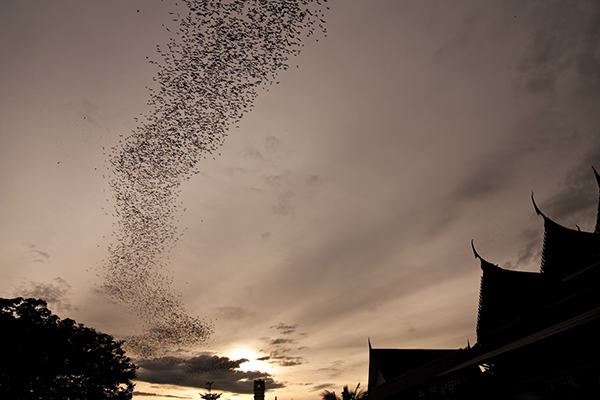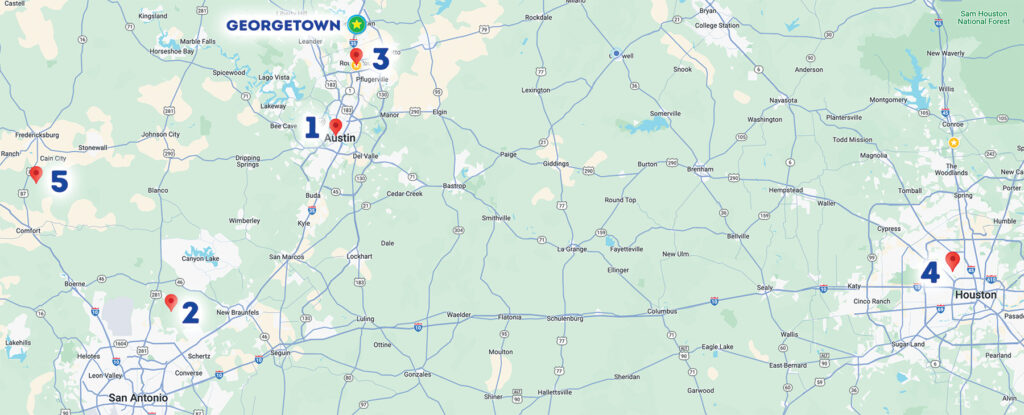Exploring Texas’ Bat Habitats
FUN FACTS
Bats are part of the mammal order Chiroptera, which has more than 1,400 species making it the second largest and most diverse order of mammals after rodents. Bats are the only mammals that can fly — some can even go as fast as 100 miles per hour.
Contrary to popular belief, bats are not actually blind but rely on echolocation – locating objects by emitting sound waves and interpreting the echoes reflected back to them – as their primary sense. Some bats use echolocation to hunt live prey, while others simply feed on fruit or nectar.
Like most mammals, bats come in all shapes and sizes. The average bat’s wingspan is about 24 inches; the largest can be as large as 5 feet, while the smallest are only 6 inches and the animal can fit in the palm of your hand.
Bats are highly social animals that usually reside in groups. They are best known for their unique habit of sleeping upside down. This position is advantageous as it facilitates a quicker and easier departure into flight, since bats are unable to gain momentum through running. Hanging upside down allows them to simply drop and swiftly take off.
Several species of bats have been known to live more than 30 years, and the oldest on record is a venerable 41-year-old Siberian bat.
Bats are gentle, nocturnal animals, feeding at night when it’s cooler. Their diets differ depending on the species—some eat insects, fruit, or nectar, while others feed on the blood of wild animals such as cattle or horses. But don’t worry — they rarely bite humans unless threatened.
Bats often get a bad rap because of their portrayal as spooky Halloween-time creatures and ties to their blood-sucking Transylvanian relative. But, in reality, bats are remarkable animals, serving as vital, unsung heroes of the ecosystem. As you plan your summer trips, be sure to add a visit to one of the many, awe-inspiring bat hideouts around Texas.
HEROES TO THE ECOSYSTEM
Bats are essential to our environment because they pollinate flowers and disperse seeds. In fact, more than 300 types of fruit and plants depend entirely on bats. So, because of our flying friends, we have bananas, mangoes, avocados, and cacao. Plus, while these fruits and plants serve as sustenance for humans and animals, they’re also important ingredients in more than 80 medications.
Not only do bats help pollinate fruits and plants, they also eat tons of pesky insects, which has saved the farming industry billions in crop damage and pesticide costs. Plus, guano (bat poop) is helpful as a highly effective fertilizer. It’s safe to say the world we live in today would not be the same without bats, which is why there are many laws protecting them.
WHERE TO HANG OUT WITH BATS

Now that you know how incredible bats are, you might want to see one — or one million — in action. Fortunately, there are plenty of spots in Texas where you can do just that as the Lone Star State is home to thousands of Mexican free-tailed bats. This medium-sized bat migrated to the United States from Mexico and mainly eats insects, including moths, flies, wasps, and mosquitoes. They are typically visible from early spring through early fall.

1: CONGRESS ST. BRIDGE
Following renovations in 1980, the Congress Street bridge became a perfect roost for Mexican free-tailed bats, who help the city by consuming and estimated 30,000 pounds of insects each night. Starting in late March, you can watch these prodigious bats emerge from beneath the bridge, soaring over Lady Bird Lake between 7:30 and 9:45 pm. Prepare to enjoy watching the emergence of a nearly 1.5 million-strong cloud for about 45 minutes. Join the gathered crowds on the nearby hill or enhance your experience with a riverboat tour or kayak to watch this nightly phenomenon. Located on South Congress Ave, just a 30-minute drive from Georgetown.
2: BRACKEN CAVE PRESERVE
If you want even more, the Bracken Cave on the northern outskirts of San Antonio is home to an estimated 20 million bats. In 1991, the Bat Conservation International (BCI) purchased the Bracken Cave, and it is not only the world’s largest bat colony, it is also the largest concentration of mammals of any kind. The Bracken bats consume an estimated 100 tons of earworm moths every night. Because Bracken Cave Preserve is located on private property managed by the Bat Conservation Interaction, it is closed to the public and reservations must be made to see the bats. However, once the bats start flying, they can be seen easily from nearby streets. 7515 Bracken Cave Rd, San Antonio, 1.5-hour drive from Georgetown.
3: MCNEIL BRIDGE
Every night between March and November, hundreds of bats embark on a nightly bug hunt from under the Interstate 35 overpass at McNeil Road in Round Rock. Free, first-come-first-served parking is available in the nearby Napa Auto Store parking lot. 601 North Interstate 35 Frontage Road, Round Rock, 15-minute drive from Georgetown.
4: WATONGA BLVD BRIDGE
Approximately 100,000 bats live under the Watonga Boulevard Bridge in downtown Houston. They typically fly out from under the bridge and along the White Oak Bayou. Many viewers enjoy watching the sight from park benches or the grass along the bayou. 4721 Watonga Blvd, Houston. 3-hour drive from Georgetown.
5: OLD TUNNEL STATE PARK
More than 3 million bats reside in the tunnel in Fredericksburg. The park is open for bat viewing from May through October, but tickets are required for park access after 5pm. 10619 Old San Antonio Rd, Fredericksburg, 2-hour drive from Georgetown.
